Eurotrip #3: Berlin
Hi everyone!
Continuing with my account of my November spent travelling, today I'll be talking about a four day trip I made to Berlin with some of my flatmates mid-November. I'd already visited before before in 2008, but I was keen to visit this huge city again and get to know it via a different style of travelling (it's not the same travelling with family as it is with friends). Also, going on your Erasmus exchange to Germany and not visiting Berlin would be a sin!
Despite the fact that there's a direct train and bus from Bremen to Berlin, the cheapest option is to get a train to Hamburg (free for students with our semester ticket) and then get a bus from there to Berlin for only 8 euros with Flixbus. Our journey then began by having to get up very early, spending an hour on the train, drinking a coffee in Hamburg and then spending three and a half hours more on the bus to Berlin, which dropped us right in the centre of former East Berlin, next to Alexanderplatz. From there, we decided to save paying for public transport and walk the 25 minutes to Karl-Marx-Allee, one of the avenues most representative of former East Berlin. Flanked by large, cold and communist-looking buildings, the avenue's magnitude and strict order creates a sense of smallness in you as you are confronted with an unfeeling and impersonal city, reflecting the system which exercised its control here. The film 'The Lives of Others' (Das Leben der Anderen) is set in this area, which portrays the strict surveillance and control over the population exercised by the German Democratic Republic.
After having walked down this long avenue, we arrived at the street where our hostel was located. At first, we wanted to stay in Hostel Wombats, since one of my friends had stayed in a hostel belonging to the same change in Munich and had told us that it was very nice. However, there weren't any beds left when we went to reserve, so we decidede to stay in Pegasus Hostel, where another of my friends had stayed a few summers before. He'd told us that it was a pretty shabby hostel, but for the low prices (we paid 46 euros per person for three nights) it wasn't bad, and had a nice feel to it. This had been in the summer though, when the hostels are usually full of backpackers and young people travelling the world, meaning it's easy to socialize with your neighbours; when we stayed in the hostel in November however, it was full of Syrian refugee families who had just arrived in Germany.
Obviously none of us have any problem with the refugees and we're definitely not racist or xenophobic (in fact, anything but), but I have to say that it was a bit awkward being the only young people and the only tourists in the hostel, because when we wanted to use the kitchen quickly before going out, it was always full of people cooking meals for their entire families, meaning the atmosphere was a bit different to what you'd normally find in youth hostels.
The seven of us stayed in a room with eight beds with our own bathroom, so we had enough privacy and space to be getting on with, and this almost meant we could pre-drink in the room before we went out without annoying anyone. The room was pretty nice, with four bunk beds and a table next to a large window. In general, the entire hostel was about 5 out of 10 with regards to cleanliness, so neither dirty nor clean. The kitchen though was really quite disgusting and had a horrible smell. However, everyone was quite convinced that for what we'd paid, the hostel was alright. Apart from me.
The reason for this is because while we were having dinner in the kitchen on our first day at the hostel, I saw a rat running about outside in the hostel's courtyard. I knew perfectly well that if I told my friends what I'd seen, chaos would erupt and nobody would be happy staying in the hostel for the four days we had remaining. So, I decided to keep quiet and suffer in silence, waiting until when we checked out to tell the others. You're welcome, guys.
In conclusion, in terms of the hostel, I wouldn't recommend it as your first option for accommodation in Berlin, but if you don't find another cheap place and all the hostels are full, it's still an option to take into consideration. Apart from the episode with the rat and the bad kitchen, our stay at the hostel was a good one.
Getting back to the story of our trip, after having left our luggage in the hostel's basement (we couldn't check in until midday) we caught the U-Bahn (metro) which was three minutes away from the hostel to Alexanderplatz, from which we started off on a more touristic tour of Berlin: the famous TV Tower on Alexanderplatz (the emblem of Communist Berlin), the Red City Hall, Museum Island, the Berliner Dom (cathedral), the luxurious avenue Unter den Linden, and the well-known Brandenburg Gate, where we met up with some French friends and took an obligatory photo.

On this walk, I have to say I was pretty surprised to discover that the Palace of the Republic, headquarters of the former GDR, had been demolished, and that in its place on Museum Island the Royal Palace of Berlin is being reconstructed. This historical building was heavily damaged in the Second World War and demolished by the Communist government in 1950, though reunified Berlin has today decided to reconstruct it and regain this proud monument for the benefit of the city.
From the Brandenburg Gate, we continued on to the Reichstag, and then to the Tiergarten, the gigantic parque located right in the city centre which houses the Bellevue Palace (residence of the Federal Republic of Germany's chancellor, Angela Merkel) and the Victory Column, which dominates the Tiergarten placed in its very centre. We stopped to eat the lunch we'd brought with us from Bremen in the park (smart savers before anything else), full of autumnal colours.
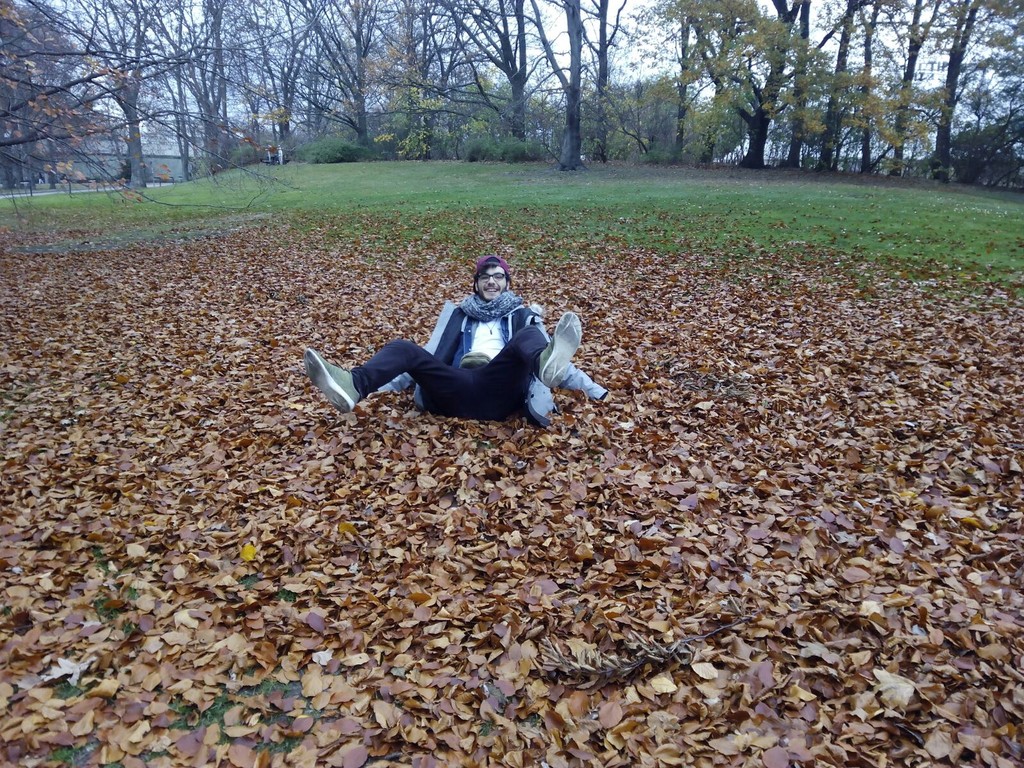
A characteristic of Berlin is the quantity of memorials in its streets and parks. On this walk we took alone, we came across a memorial to all victims of war and repression on Unter den Linden, another to the victims of persecution and genocide of gypsy origin in the Nazi concentration camps, another to persecuted homosexuals during the Third Reich, another to the Jews murdered in the Holocaust... after eating, we visited these last two, exiting the park just next to the memorial to homosexual victims of National Socialist repression. This monument consists of a black block with a small opening, through which you can see a projection of two men kissing in the same spot as the monument.
Right in front of this small memorial is the huge Memorial to the Murdered Jews of Europe, formed of 2, 711 black rectangular blocks. These blocks, all different sizes, form long corridors of varying height. In this way, the visitor passes through the monument becoming lost among the labyrinthine passageways.
Your impression of this monument varies depending on how you visit it. It's always full of people running and playing among the blocks, which makes it seem like just an amusing labyrinth; if you decide to walk around it alone and in silence, absorbed in your own reflections about the atrocity of the Holocaust, however, it can be quite an intense experience. When we visited it on our first day we didn't take it very seriously, but when we returned on the Monday on the Free Tour, the guide recommended that we walk around it alone. For me, it was a really chilling experience, since the memorial makes you feel disorientated and incapable of fathoming the magnitude of the Holocaust. It had also been raining on this day, meaning that the impermeable blocks were covered with a spattering of raindrops, as if a symbol of the Jewish population's suffering.
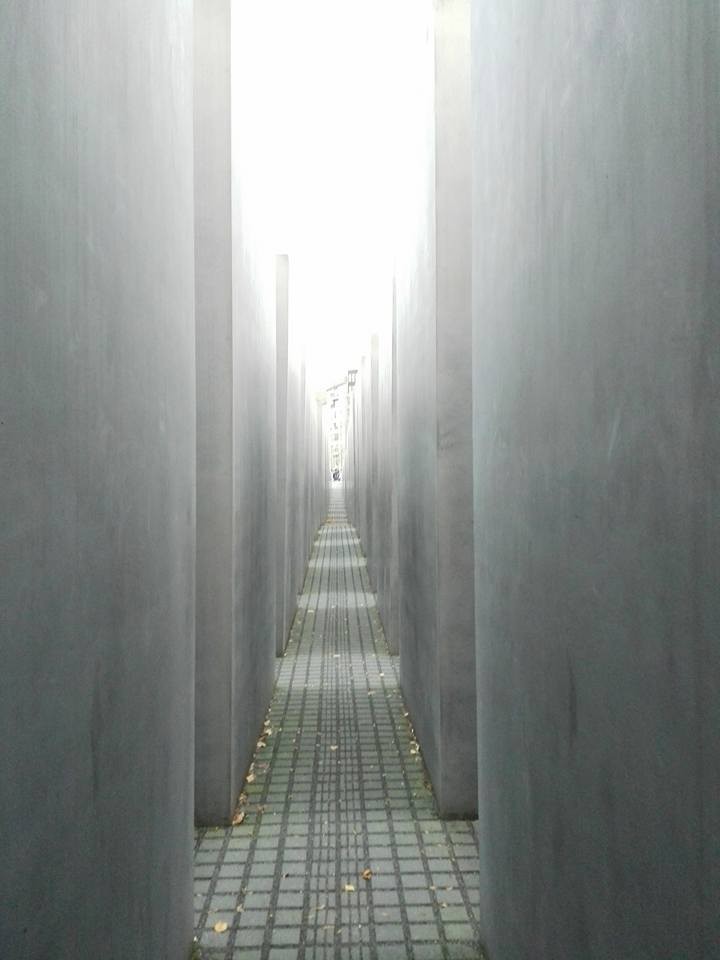
After we had visited the monument, we made our way to a nearby car park, beneath which Hitler's bunker had been. In my opinion, this visit was a bit unnecessary, since there isn't much interesting to see - just an information board telling you that eight metres below your feet is where Hitler's bunker used to be, where he spent the last moments of his life.
Our next destination was Potsdamer Platz, one of the places in Berlin which has changed the most since the fall of the wall. When my parents visited Berlin in 1984, Potsdamer Platz was a gigantic wasteland divided by the wall and with a series of footbridges on the Western side to allow people to look over to the west. This square is now a vibrant hub of communication surrounded by large, modern skyscrapers, symbols of the new prosperous and Capitalist Germany, which has emerged as the main economic power in Europe since reunification in 1989. The Sony Center is especially interesting; a large public space whose roof is an unusual umbrella-like structure of metal and glass.
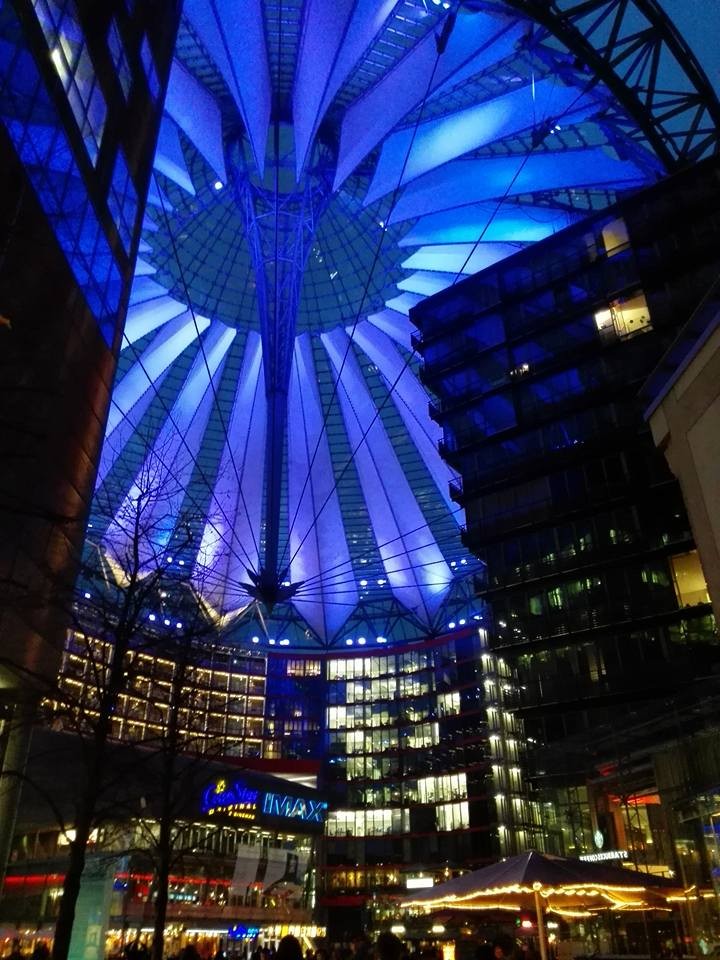
After this long walk through the city, we decided to catch the metro to go back to the hostel for a rest, since we still wanted to enjoy the Berlin nightlife later on. Berlin is well-known for being one of the European cities with the best nightlife, above all for electro music: it's known as the 'techno capital'. The majority of the nightlife is concentrated in the Kreuzberg and Friedrichshain districts, with its epicentre on Warschauer Straße. The most surprising thing about this area is the location of the nightclubs, which are mostly housed in old industrial buildings, electrical plants or old department stores. There are several famous techno clubs, such as Berghain, Tresor and Watergate, but if you're just visiting the German capital, they won't let you in.
These clubs exploit their enormous popularity (there are two-hour queues to get in) by being especially strict with their entrance policy. Friends of ours who have spent more time in Germany than us told us that to get in, you have to fulfil a series of pretty random selection criteria which I just can't understand at all: you've got to seem like you like techno music, come in a small group, not talk in a language which isn't German, not look at your phone in the queue, not try and get in when you're too drunk... some French friends of us tried to get in to Berghain twice without success, but we decided that it wasn't worth queueing for so long when we probably wouldn't get any for really xenophobic reasons, like speaking Spanish or English in the queue.
So, after a rest and getting ready at the hostel, we headed to the busiest area of Warschauer Straße, where lots of old department store buildings house several small nightclubs. However, although these weren't places as strict as Berghain or Watergate, we found that a lot of places wouldn't let us in since we were seven people, so I recommend splitting into smaller groups if you want to get in to these clubs. In the end, we got into the cheapest one which would let us in (the entrance fee was five euros), though none of us can remember its name. The place and music were good, but there weren't that many people in there, which lead us to suspect that they'd only let us in all together since they needed more people. Despite this, we had a pretty good time and it was quite a funny night. We ended it with a cheap and tasty kebab on our way back to the hostel, the way every good night out should end!
The following day, we made an effort to combat our hangovers and walked to the East Side Gallery, a kilometre-long fragment of the Berlin Wall which was preserved and turned into a fantastic open-air art gallery, where over 150 artists expressed their joy at the fall of the Iron Curtain in Europe and their rejection of every kind of war, conflict and the separation of peoples all over the world. When I visited Berlin in 2008, the murals were in a bad state in terms of their preservation since thousands of stupid visitors had decided that it was a good idea to write their names or stupid 'Viva Badajoz' or 'I love Berlin' messages on the works of art. Fortunately, in 2009 a restoration project was begun, meaning that some of the art has already been completely restored, while others where the restoration is still on-going are surrounded by fencing.
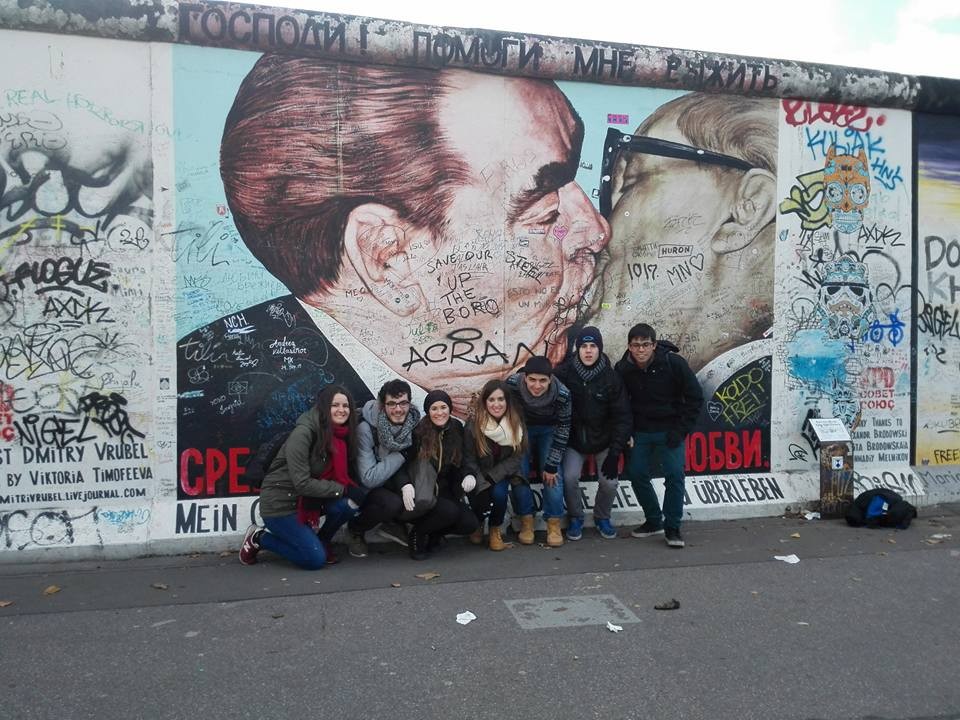
After walking along the East Side Gallery, we crossed over the beautiful reddish Oberbaumbrücke towards Kreuzberg, the most alternative neighbourhood in all of Berlin, where we visited Görlitzer Park, which I hear is always full of activity in the summer months (when we visited, there were just people selling drugs... ) and has numerous record, vintage clothing and piercing shops along Oranienstraße. We walked along here in the direction of Checkpoint Charlie. Along the way, we stopped at a metro station to hide from the cold and eat the sandwiches we'd bought from the supermarket in front of the hostel for only 90 cents (everything was so cheap! ). Continuing on our way, we saw some apparently very normal things such as this gigantic phallus which stretched across a building's entire facade:
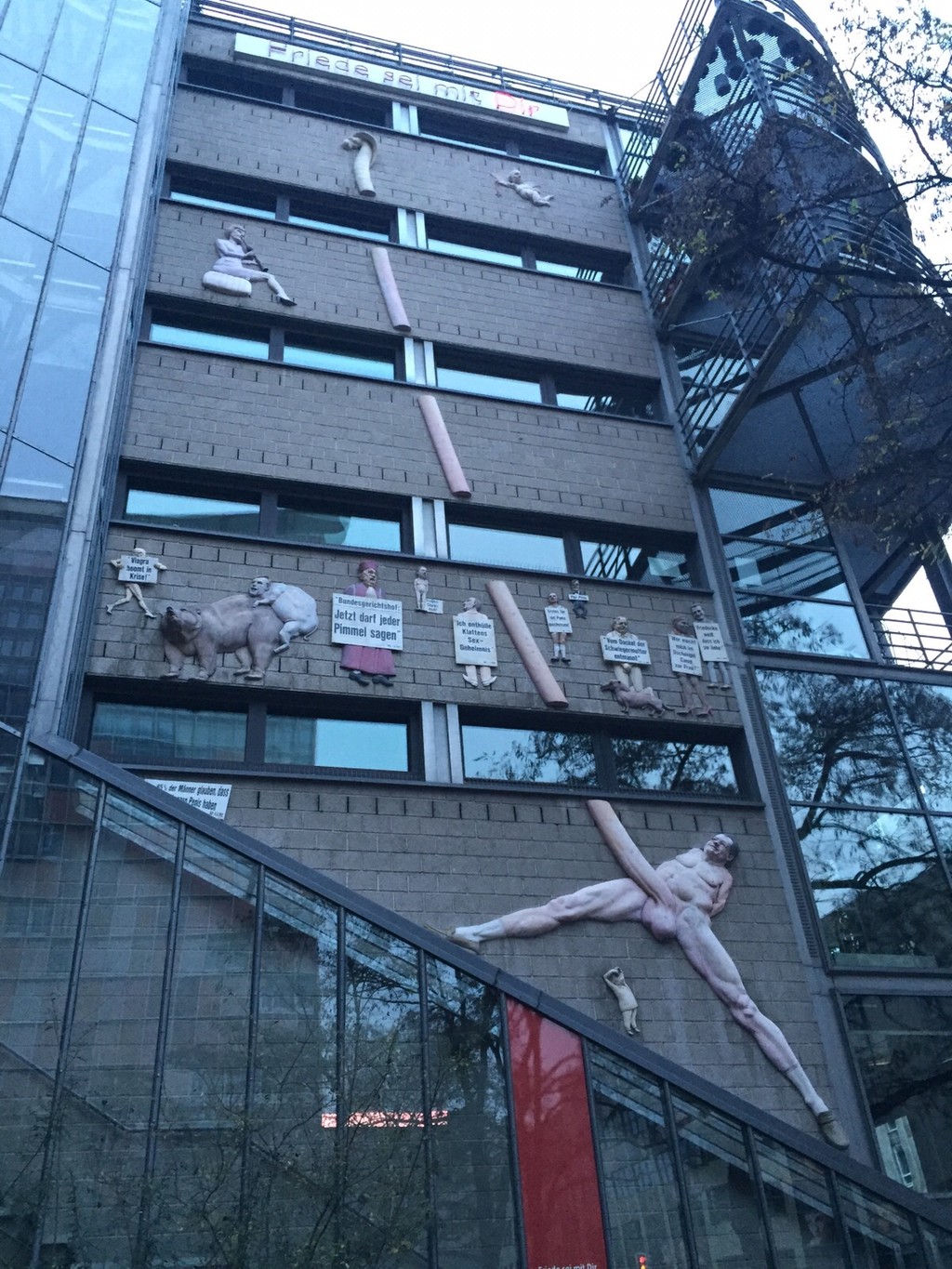
Next we visited the Topography of Terror, a museum built atop the ruins of the Gestapo's main headquarters and which narrates the development of Nazism in Germany, explaining the function of the Third Reich in depth and the innumerable atrocities that it involved. I definitely recommend a visit to this exposition, since although some of it is quite disturbing, it's very useful for fully understanding what happened in Germany and in Europe as a whole between 1933 and 1945. Entrance is also completely free, as are most German museums relating to the Third Reich or the Cold War. After this, we decided to go back to the hostel for a rest and to have dinner before going out partying again, but first we paid another visit to the Brandenburg Gate, which had been lit up in the colours of the French flag as a symbol of Germany's support for the victims of the attack, which had taken place the night before. Lots of people had gathered in front of the French embassy, which is located on the same square, leaving flowers, candles and messages in memorial of the victims and condemning terrorist violence.
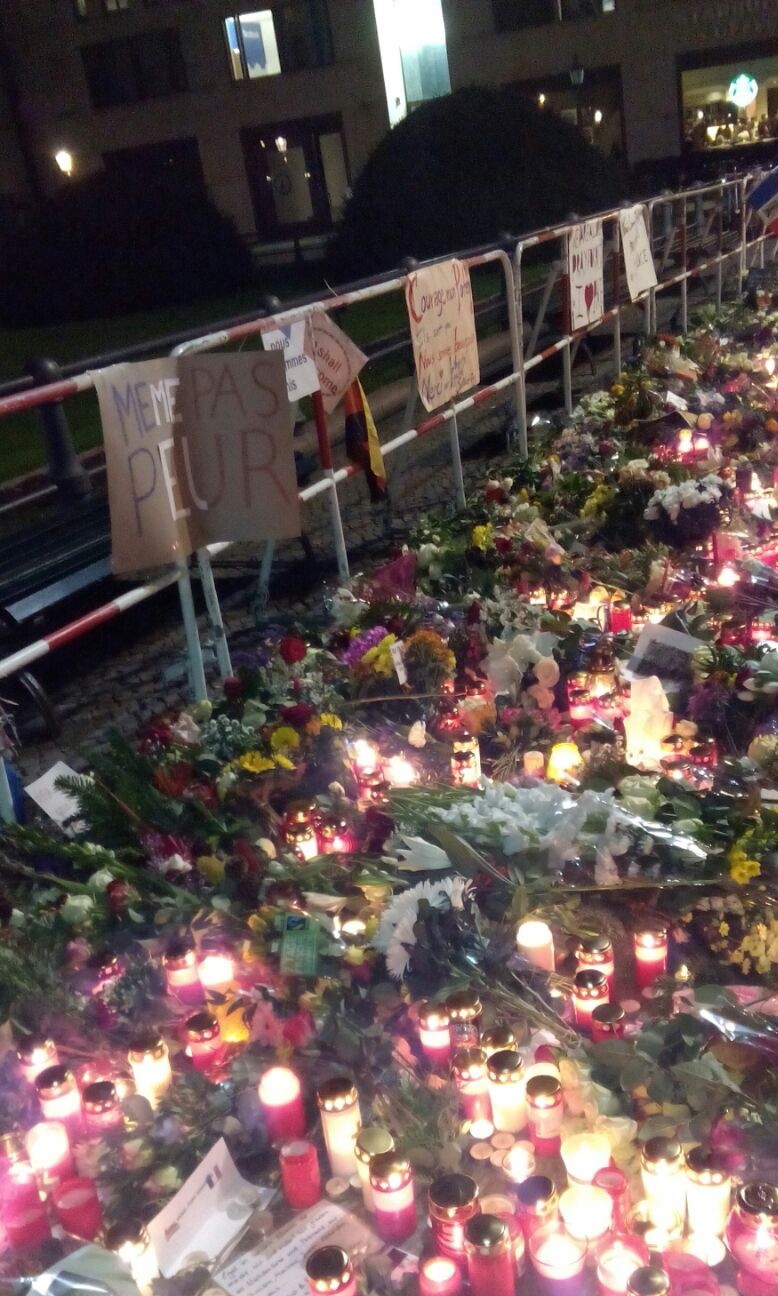
Since we hadn't used the metro all day, we hadn't bought ourselves a transport ticket (the cheapest option for groups is to combine a five person group day ticket with individual all-day tickets, which worked out as costing three or four euros per person per day as there were seven of us). We were in the station fighting with the ticket machines when suddenly our train arrived, so we decided to get on without having bought tickets and buy them when we next had to change trains. Biiiiiig mistake. We only saw one ticket officer in the four days we were in Berlin, and we only travelled without tickets once, so of course, luck would have it that these two things occurred at the same time. Three of us were given 60 euro fines (the other four managed to get away in time). Some advice then: either pay for all your tickets in Berlin or risk it and don't pay for any, but don't end up like us and get caught out just the one time!
After we'd finished complaining and squabbling about the fine in the hostel, we got ready to go out clubbing again. This time we went to a club called Matrix which is below the Warschauer Straße train station. Although it's not one of the cult hangouts for Berlin techno lovers, it's a huge club (with nine rooms) with loads of people and a great atmosphere, with different kinds of music playing in each room. The entrance fee was 10 euros, but it was totally worth it, since it was a fantastic night out. You'll also have no problem getting in here, as it's somewhere you can definitely enjoy the Berlin nightlife without being a massive techno fan.
The following day we spent the best part of the morning regaining our strength (it was like having a constant hangover, haha), after which we headed to Bernauer Straße, where the Wall Memorial is. It's a kind of park cum memorial where the stories are told of some of the families who lived in the street which was located just at the meeting point of the east and west border. The Wall divided families and neighbours for almost three decades. Right next to the park is a very interesting museum about the Wall, which among other things explains everything that happened in Germany between the end of the Second Word War and the building of the Wall, information that people don't often know about. From the top of this building, you can also see a fragment of the Wall which has been conserved exactly as once was, including the empty area known as the 'death strip' between the two walls which made up the barrier between the two Germanys.
After this, we wanted to go to the Flohmarkt (flea market) in the Mauerpark, which is on every Sunday, but it turned out to be the Volkstrauertag (a day of national mourning) where the German people commemorate the victims of all wars or totalitarian regimes in the world, so the market wasn't on. Instead then, we went to Oranienburger Straße to see the Tacheles squatters' house, but this too was closed.
The next day, the Monday, we got up early and went to the Reichstag (the German Parliament) since we had booked to enter and visit its famous cupola designed by Norman Foster at 8am, where I split my lip on a visit in 2008 (this is what you get for being travel-mad and clumsy). Visiting the cupola is free and totally worth doing, not just due to the fact it's an amazing work of architecture, but also due to its wonderful views of Berlin. You have to reserve your entrance ticket in advance on the Reichstag web site, though you can also try to get in while there by asking if there have been any cancelled reservations. To do this, you'll need to go to the office next to the Reichstag, next to the Tiergarten, and ask.
After this visit, we walked around to pass the time until 11am, when we were due to go on a free tour through Berlin. For those of you who don't know, a free tour is a new idea of a guided tour where they don't ask you for money before it starts, leaving you to decide at the end how much you'd like to pay the guide (or not at all). It was a great experience, since you get to visit all the main monuments in the area, and though we'd already seen most of them, the guide gave us more interesting information on them in Spanish. It's definitely one of the best ways to explore this area of Berlin, so I'll leave you the link to the company who organises these tours, called New Tours Berlin.
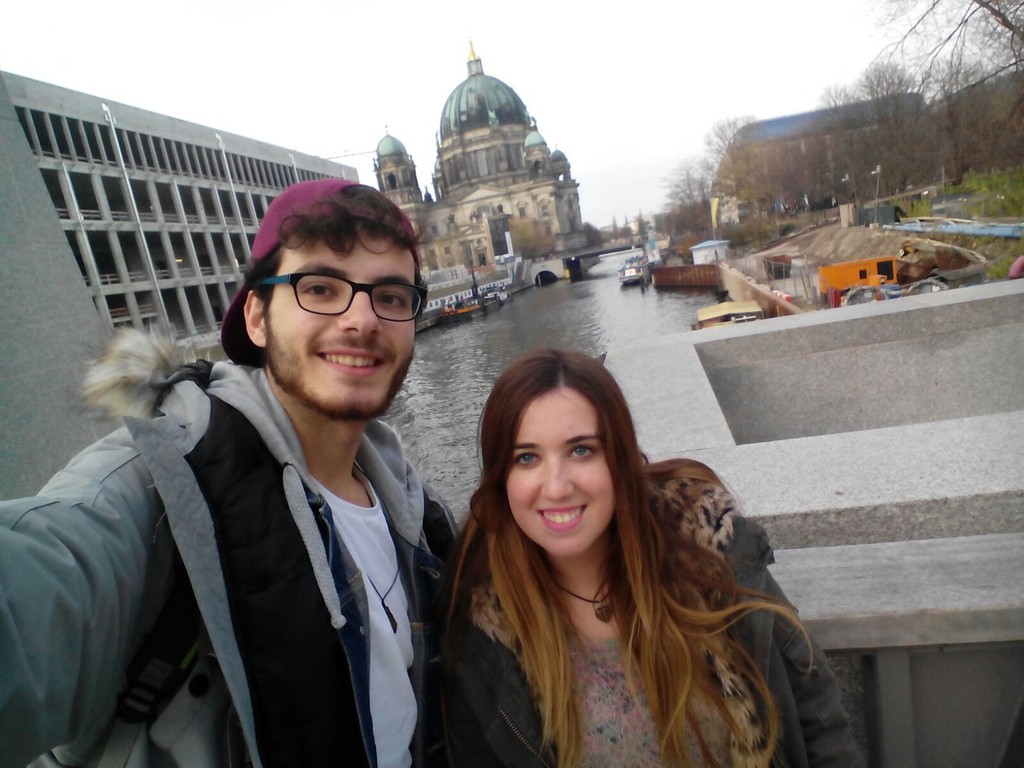
The tour started at the Brandenburg Gate and lasted between two and three hours, ending at Bebelplatz, the square where the Nazis held their famous book burning in 1933, which is commemorated by a strange memorial in the centre of the square. At the end of the tour, we got the metro to Mehringdamm next to a small kiosk claiming to sell the 'best kebabs in Europe'. I don't know if they were the best on the continent, but they were definitely the best I'd ever tried, since they add lemon, mint and vegetables to it (and the kebab itself only costs 4. 30 euros). Our stomachs filled with kebab, we headed to the Jewish Memorial again with the intention of visiting the underground museum there. We read on a sign however that the museum was closed on Mondays, but the door was half open, so we went in. After about five minutes though, a security guard caught us and told us to leave. Without anything better to do, we decided to go back to the hostel and spend a few hours relaxing in the reception area until it was time to catch our bus back to Hamburg.
My conclusion to this trip is that although we travelled on an incredibly low budget, you'll definitely laugh at yourself eating mouldy bread in a shabby Berlin metro station, or cooking probably the most disgusting white rice we've ever eaten in our lives surrounded by Syrian refugees and a hidden rat. They were four incredible days in the huge city that is Berlin, and I was continually surprised by its different sides and by the history it harbours, making it definitely one of the cities I'd most like to live in out of all the ones I've visited.
Until next time!
Photo gallery
Content available in other languages
- Español: Eurotrip #3: Berlín
- Italiano: Eurotrip #3: Berlín
- Français: Eurotrip #3: Berlín
- Deutsch: Eurotrip #3: Berlin
Want to have your own Erasmus blog?
If you are experiencing living abroad, you're an avid traveller or want to promote the city where you live... create your own blog and share your adventures!
I want to create my Erasmus blog! →























Comments (0 comments)